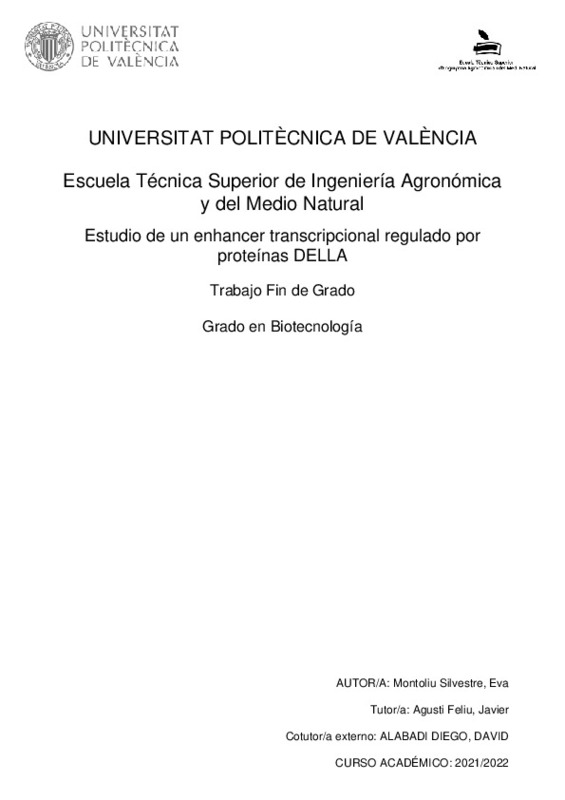|
Resumen:
|
[ES] La expresión de un gen suele estar determinada por la presencia en su región promotora de elementos cis distales llamados enhancers. Estos elementos son unidos por factores de transcripción (TFs) que reclutan la ...[+]
[ES] La expresión de un gen suele estar determinada por la presencia en su región promotora de elementos cis distales llamados enhancers. Estos elementos son unidos por factores de transcripción (TFs) que reclutan la maquinaria basal de transcripción para promover la expresión del gen. Investigaciones recientes en plantas muestran que, al igual que ocurre en animales, los enhancers interaccionan físicamente con el promotor proximal o con intrones para promover la expresión del gen diana, formando lo que se conoce como loops. En este TFG se va a investigar la regulación del gen GID1a de Arabidopsis por un posible enhancer. GID1a codifica un receptor de giberelinas y su expresión se promueve por los reguladores transcripcionales DELLA. En primer lugar, hemos hecho el análisis bioinformático de un experimento ChIP-seq de la proteína DELLA RGA. Hemos observado que esta proteína se une preferentemente alrededor del inicio de la transcripción (TSS) de los genes diana y en sus promotores, entre ellos el de GID1a. Varias evidencias apuntan a que la región unida por RGA en el gen GID1a puede actuar como un enhancer : (i) la región que une RGA colocaliza con la RNAPII y el complejo MEDIATOR; (ii) la región unida por RGA es accesible; y (iii) un análisis global de conformación de la cromatina indica que la región donde se une RGA interacciona físicamente con el intrón del gen, apuntando a que se podría formar un loop. Para probar esta hipótesis, hemos preparado dos tipos de construcciones con fusiones al gen testigo GUS: (i) la región que une RGA, en ambas orientaciones, más un promotor mínimo; y (ii) versiones del pGID1a en las que omitimos el intron o la región de unión de RGA. Durante el TFG, hemos obtenido plantas transgénicas de Arabidopsis que expresan las dos versiones de la región que une RGA fusionadas a GUS. Nuestro análisis muestra que esta región es suficiente para promover la expresión del testigo de manera dependiente de DELLAs. Este resultado lo hemos confirmado mediante expresión transitoria de una fusión de la misma región al gen LUCIFERASA (LUC) y su ensayo en hojas de Nicotiana benthamiana. La actividad LUC aumenta al coexpresar una proteína DELLA. Nuestros resultados indican que la regulación del gen GID1a por DELLAs ocurre a través de la unión de estas a un elemento cis en su promotor que actúa como enhancer transcripcional
[-]
[EN] The expression of a gene is usually determined by the presence in its promoter region of distal cis-elements called enhancers. These elements are bound by transcription factors (TFs) that recruit the basal transcription ...[+]
[EN] The expression of a gene is usually determined by the presence in its promoter region of distal cis-elements called enhancers. These elements are bound by transcription factors (TFs) that recruit the basal transcription machinery to promote gene expression. Recent research in plants shows that, as in animals, enhancers physically interact with the proximal promoter or introns to promote the expression of the target gene, forming what are known as loops. In this TFG we will investigate the regulation of the Arabidopsis GID1a gene by a putative enhancer. GID1a encodes a gibberellin receptor and its expression is promoted by DELLA transcriptional regulators. First, we have per- formed bioinformatic analysis of a ChIP-seq experiment of the DELLA RGA protein. We observed that this protein binds preferentially around the transcriptional start of transcription (TSS) of tar- get genes and at their promoters, including that of GID1a. Several evidences point to the fact that the RGA-binding region in the GID1a gene may act as an enhancer: (i) the RGA-binding region colocalizes with RNAPII and the MEDIATOR complex; (ii) the RGA-binding region is accessible; and (iii) a global chromatin conformation analysis indicates that the RGA-binding region physi- cally interacts with the intron of the gene, suggesting that a loop could be formed. To test this hypothesis, we have prepared two types of constructs with fusions to the GUS control gene: (i) the RGA-binding region, in both orientations, plus a minimal promoter; and (ii) versions of pGID1a in which we omitted the intron or the RGA-binding region. During TFG, we obtained transgenic Arabidopsis plants expressing both versions of the RGA-binding region fused to GUS. Our analysis shows that this region is sufficient to promote the expression of the control in a DELLAs-dependent manner. We have confirmed this result by transient expression of a fusion of the same region to the LUCIFERASE (LUC) gene and its assay in Nicotiana benthamiana leaves. LUC activity increases upon co-expression of a DELLA protein. Our results indicate that the regulation of the GID1a gene by DELLAs occurs through the binding of DELLAs to a cis-element in its promoter that acts as a transcriptional enhancer.
[-]
|








